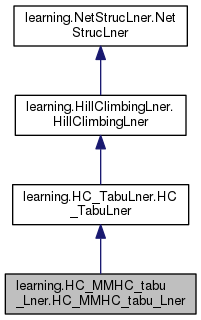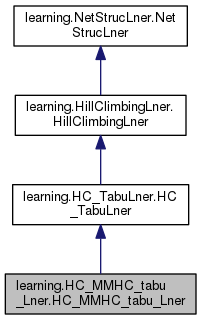|
| def | __init__ (self, states_df, score_type, max_num_mtries, alpha=0, tabu_len=10, ess=1.0, verbose=False, vtx_to_states=None) |
| |
| def | move_approved (self, move) |
| |
| def | __init__ (self, states_df, score_type, max_num_mtries, tabu_len=10, ess=1.0, verbose=False, vtx_to_states=None) |
| |
| def | move_approved (self, move) |
| |
| def | finish_do_move (self, move) |
| |
| def | restart (self, mtry_num) |
| |
| def | __init__ (self, states_df, score_type, max_num_mtries, ess=1.0, verbose=False, vtx_to_states=None) |
| |
| def | climb (self) |
| |
| def | do_move (self, move, score_change, do_finish=True) |
| |
| def | refresh_nx_graph (self) |
| |
| def | would_create_cycle (self, move) |
| |
| def | move_approved (self, move) |
| |
| def | finish_do_move (self, move) |
| |
| def | restart (self, mtry_num) |
| |
| def | cache_this (self, move, score_change) |
| |
| def | empty_cache (self) |
| |
| def | __init__ (self, is_quantum, states_df, vtx_to_states=None) |
| |
| def | fill_bnet_with_parents (self, vtx_to_parents) |
| |
The class HC_MMHC_tabu_Lner (Hill Climbing Min-Max Hill Climbing Tabu
Learner) is a child of HC_TabuLner. It adds to the latter a search at
the beginning of the learning process of the PC (parents children,
aka neighbors) set of each node. This knowledge is then used in the
move_allowed() function to forbid any 'add' moves unless they add arrows
compatible with the PC list of each node.
References
----------
1. Tsamardinos I, Brown LE, Aliferis CF (2006). "The Max-Min
Hill-Climbing Bayesian Network Structure Learning Algorithm". Machine
Learning, 65(1), 31-78.
Attributes
----------
is_quantum : bool
True for quantum bnets amd False for classical bnets
bnet : BayesNet
a BayesNet in which we store what is learned
states_df : pandas.DataFrame
a Pandas DataFrame with training data. column = node and row =
sample. Each row/sample gives the state of the col/node.
ord_nodes : list[DirectedNode]
a list of DirectedNode's named and in the same order as the column
labels of self.states_df.
max_num_mtries : int
maximum number of move tries
nx_graph : networkx.DiGraph
a networkx directed graph used to store arrows
score_type : str
score type, either 'LL', 'BIC, 'AIC', 'BDEU' or 'K2'
scorer : NetStrucScorer
object of NetStrucScorer class that keeps a running record of scores
verbose : bool
True for this prints a running commentary to console
vertices : list[str]
list of vertices (node names). Same as states_df.columns
vtx_to_parents : dict[str, list[str]]
dictionary mapping each vertex to a list of its parents's names
tabu_list : list[tuple[str, str, str]]
a list of the previous moves. The list's length is specified in the
constructor by means of tabu_len parameter. Every time a new move is
added to end of the tabu list, the first item of the list is removed.
best_loc_max_graph : networkx.DiGraph
best_loc_max_score : float
Every time the restart() function is called because a try yields no
moves with positive score change, we infer that a new local max has
been reached. If total score of the current loc max is higher than
best_loc_mac_score, we replace both best_loc_max_score and
best_loc_max_graph by those of the better local max.
loc_max_ctr : int
local maximum counter, counts the number of local maxs encountered.
vtx_to_nbors : dict[str, list[str]]
a dictionary mapping each vertex to a list of its neighbors. The
literature also calls the set of neighbors of a vertex its PC (
parents-children) set.
alpha : float
threshold used for deciding whether a conditional or unconditional
mutual info is said to be close to zero (independence) or not (
dependence). The error in a data entropy is on the order of ln(n+1)
- ln(n) \approx 1/n where n is the number of samples so 5/n is a
good default value for alpha.




 Public Member Functions inherited from learning.HC_TabuLner.HC_TabuLner
Public Member Functions inherited from learning.HC_TabuLner.HC_TabuLner Public Member Functions inherited from learning.HillClimbingLner.HillClimbingLner
Public Member Functions inherited from learning.HillClimbingLner.HillClimbingLner Public Member Functions inherited from learning.NetStrucLner.NetStrucLner
Public Member Functions inherited from learning.NetStrucLner.NetStrucLner Public Attributes inherited from learning.HC_TabuLner.HC_TabuLner
Public Attributes inherited from learning.HC_TabuLner.HC_TabuLner Public Attributes inherited from learning.HillClimbingLner.HillClimbingLner
Public Attributes inherited from learning.HillClimbingLner.HillClimbingLner Public Attributes inherited from learning.NetStrucLner.NetStrucLner
Public Attributes inherited from learning.NetStrucLner.NetStrucLner Static Public Member Functions inherited from learning.HC_TabuLner.HC_TabuLner
Static Public Member Functions inherited from learning.HC_TabuLner.HC_TabuLner Static Public Member Functions inherited from learning.HillClimbingLner.HillClimbingLner
Static Public Member Functions inherited from learning.HillClimbingLner.HillClimbingLner Static Public Member Functions inherited from learning.NetStrucLner.NetStrucLner
Static Public Member Functions inherited from learning.NetStrucLner.NetStrucLner 1.8.11
1.8.11